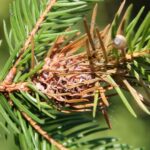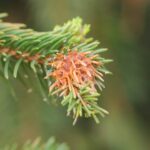Cooley Spruce Gall Adelgid
Gall Making Insects & Mites
The Cooley Spruce Gall Adelgid (Adelges cooleyi) is a small, sap-sucking insect that belongs to the family Adelgidae. It is native to North America and is a pest of spruce trees, particularly the Colorado blue spruce. This insect feeds on the sap of spruce trees and causes the formation of galls, which are small, round, tumor-like growths that form on the needles of infested trees. The galls are initially green, but eventually turn brown and harden as the adelgid matures and feeds inside.
Infestation by the Cooley spruce gall adelgid can weaken the tree, reducing its vigor and growth rate, and can cause significant aesthetic damage to the needles. In severe cases, the infestation can lead to tree death. This pest has a single generation per year and overwinters as a juvenile stage on the needles. In the spring, it feeds and lays eggs, which then hatch into nymphs that continue to feed and grow. The nymphs produce the hormone that causes the galls to form, which they use as a protective covering while they mature and feed.
Control of the Cooley spruce gall adelgid is best achieved through a combination of cultural practices, such as pruning out infested branches, and chemical control, such as insecticidal soap or horticultural oil sprays applied when the insects are in the nymphal stage. In addition, the use of resistant cultivars, such as Norway spruce, can also help reduce the impact of this pest. Early detection and treatment of infestations is important to prevent the spread of the adelgid and the resulting damage to spruce trees.




